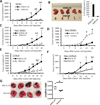Tumor-derived IL-35 promotes tumor growth by enhancing myeloid cell accumulation and angiogenesis
- PMID: 23345334
- PMCID: PMC3578001
- DOI: 10.4049/jimmunol.1202535
Tumor-derived IL-35 promotes tumor growth by enhancing myeloid cell accumulation and angiogenesis
Abstract
IL-35 is a member of the IL-12 family of cytokines that is comprised of an IL-12 p35 subunit and an IL-12 p40-related protein subunit, EBV-induced gene 3 (EBI3). IL-35 functions through IL-35R and has a potent immune-suppressive activity. Although IL-35 was demonstrated to be produced by regulatory T cells, gene-expression analysis revealed that it is likely to have a wider distribution, including expression in cancer cells. In this study, we demonstrated that IL-35 is produced in human cancer tissues, such as large B cell lymphoma, nasopharyngeal carcinoma, and melanoma. To determine the roles of tumor-derived IL-35 in tumorigenesis and tumor immunity, we generated IL-35-producing plasmacytoma J558 and B16 melanoma cells and observed that the expression of IL-35 in cancer cells does not affect their growth and survival in vitro, but it stimulates tumorigenesis in both immune-competent and Rag1/2-deficient mice. Tumor-derived IL-35 increases CD11b(+)Gr1(+) myeloid cell accumulation in the tumor microenvironment and, thereby, promotes tumor angiogenesis. In immune-competent mice, spontaneous CTL responses to tumors are diminished. IL-35 does not directly inhibit tumor Ag-specific CD8(+) T cell activation, differentiation, and effector functions. However, IL-35-treated cancer cells had increased expression of gp130 and reduced sensitivity to CTL destruction. Thus, our study indicates novel functions for IL-35 in promoting tumor growth via the enhancement of myeloid cell accumulation, tumor angiogenesis, and suppression of tumor immunity.
Figures









Similar articles
-
Tumor angiogenesis mediated by myeloid cells is negatively regulated by CEACAM1.Cancer Res. 2012 May 1;72(9):2239-50. doi: 10.1158/0008-5472.CAN-11-3016. Epub 2012 Mar 9. Cancer Res. 2012. PMID: 22406619 Free PMC article.
-
Inhibition of IL-17A in tumor microenvironment augments cytotoxicity of tumor-infiltrating lymphocytes in tumor-bearing mice.PLoS One. 2013;8(1):e53131. doi: 10.1371/journal.pone.0053131. Epub 2013 Jan 25. PLoS One. 2013. PMID: 23372655 Free PMC article.
-
T cells contribute to tumor progression by favoring pro-tumoral properties of intra-tumoral myeloid cells in a mouse model for spontaneous melanoma.PLoS One. 2011;6(5):e20235. doi: 10.1371/journal.pone.0020235. Epub 2011 May 25. PLoS One. 2011. PMID: 21633700 Free PMC article.
-
Biological effects of IL-21 on immune cells and its potential for cancer treatment.Int Immunopharmacol. 2024 Jan 5;126:111154. doi: 10.1016/j.intimp.2023.111154. Epub 2023 Nov 15. Int Immunopharmacol. 2024. PMID: 37977064 Review.
-
mda-7/IL-24: a unique member of the IL-10 gene family promoting cancer-targeted toxicity.Cytokine Growth Factor Rev. 2010 Oct;21(5):381-91. doi: 10.1016/j.cytogfr.2010.08.004. Cytokine Growth Factor Rev. 2010. PMID: 20926331 Free PMC article. Review.
Cited by
-
Quantitative Systems Pharmacology Approaches for Immuno-Oncology: Adding Virtual Patients to the Development Paradigm.Clin Pharmacol Ther. 2021 Mar;109(3):605-618. doi: 10.1002/cpt.1987. Epub 2020 Aug 14. Clin Pharmacol Ther. 2021. PMID: 32686076 Free PMC article. Review.
-
Elevated M-MDSCs in Circulation Are Indicative of Poor Prognosis in Diffuse Large B-Cell Lymphoma Patients.J Clin Med. 2021 Apr 19;10(8):1768. doi: 10.3390/jcm10081768. J Clin Med. 2021. PMID: 33921711 Free PMC article.
-
Elevated Plasma Interleukin-35 as a Prognostic Indicator in Localized Clear Cell Renal Cell Carcinoma.Evid Based Complement Alternat Med. 2022 Sep 10;2022:6886590. doi: 10.1155/2022/6886590. eCollection 2022. Evid Based Complement Alternat Med. 2022. Retraction in: Evid Based Complement Alternat Med. 2023 Jun 21;2023:9846548. doi: 10.1155/2023/9846548. PMID: 36124013 Free PMC article. Retracted.
-
IL-35 inhibits CD8+ T cells activity by suppressing expression of costimulatory molecule CD28 and Th1 cytokine production.Transl Cancer Res. 2019 Aug;8(4):1319-1325. doi: 10.21037/tcr.2019.07.30. Transl Cancer Res. 2019. PMID: 35116874 Free PMC article.
-
Role of Cytokines and Chemokines in Angiogenesis in a Tumor Context.Cancers (Basel). 2022 May 16;14(10):2446. doi: 10.3390/cancers14102446. Cancers (Basel). 2022. PMID: 35626056 Free PMC article. Review.
References
-
- Niedbala W, Wei XQ, Cai B, Hueber AJ, Leung BP, McInnes IB, Liew FY. IL-35 is a novel cytokine with therapeutic effects against collagen-induced arthritis through the expansion of regulatory T cells and suppression of Th17 cells. Eur J Immunol. 2007;37:3021–3029. - PubMed
-
- Collison LW, Workman CJ, Kuo TT, Boyd K, Wang Y, Vignali KM, Cross R, Sehy D, Blumberg RS, Vignali DA. The inhibitory cytokine IL-35 contributes to regulatory T-cell function. Nature. 2007;450:566–569. - PubMed
-
- Bardel E, Larousserie F, Charlot-Rabiega P, Coulomb-L'Hermine A, Devergne O. Human CD4+ CD25+ Foxp3+ regulatory T cells do not constitutively express IL-35. J Immunol. 2008;181:6898–6905. - PubMed
Publication types
MeSH terms
Substances
Grants and funding
LinkOut - more resources
Full Text Sources
Other Literature Sources
Medical
Research Materials

